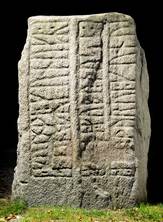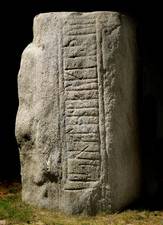The history of this family is very difficult. There are several Harald-Klack or Klack-Harald in the ancient stories. It is difficult to separate them from one another and make the dates fit. I'm using the best guess and FMG's interpretations for the most part. All information needs to be used carefully.
There is conflicting information on the parentage of Thyra (Danebod), wife of Gorm. The Roskilde Chronicle as listed on the Roskilde Cathedral history web site lists Anund IV "Ring", The King of Svealand, in 935 as the her father. He lived from 882 and dies about 940 (not possible to be her father with these dates). Her great grandfather would then by Bjorn I "Ironsides" King of Sweden 861. Gwyn Jones in the History of the Vikings thinks her father is possibly English. Jones goes on to state that there were two kings of Jutland, Horik son of Godfred and Harald Klak son of Harald. Godfred had fought against his half brother Harald's descendants but when he died the battle continue with Horik finally driving Harald Klak out of Jutland 827. [Jones 105]
Wheaton writes,
"Gorm, the son of Harde-Knud I, surnamed the Old, from the length of his reign, was enabled, by a similar concurrence of circumstances, to subdue the petty kings of Jutland, and to unite into one state the different countries which no constitute the Danish monarchy, including the provinces of Scania and Halland, since ceded to Sweden by the treaty of 1720. This change was facilitated both in Norway and Denmark by the absence of many of the petty kings, Jarls, and principal chieftains, in distant sea-roving and other predatory expeditions. Gorm had distinguished himself in his early youth for his wild, adventurous spirit in common with the other Norman invaders of France, was subsequently engaged in a sea-roving expedition along the coasts of the Baltic, and penetrated with a band of Vaeringjar and other adventurers to Smolensko and Kiow(Kiev), in Russia. He had espoused the famous Thyra Dannebod, daughter of Hararld, a Jarl of Jutland, who was converted to Christianity in France, during the reign of Louis le Debonnaire, and had caused his daughter to be baptized into the new religion in her childhood. Her influence contributed to induce King Gorm to tolerate the preaching of the Christian Missionaries in his dominions, although he continued to revere the ancient national deities who had been worshiped by his ancestors."
[Wheaton 266-267]
Gorm was described as an "obdurate heathen" by the Christian historian Adam Bede.


The Small Stone at Jelling, Denmark about 950 AD
The inscription reads: “King Gorm made these runes in honour of his wife Thyra, the pride of Denmark”.
In 815 there are entries of the Royal Annals focusing on the campaign for restoring Harald to his throne.
"The emperor [Louis] commanded that Saxons and Obodrites should prepare for this campaign, and twice in that winter the attempt was made to cross the Elbe. But since the weather suddenly turned and made the ice on the river melt, the campaign was held up. Finally, when the winter was over, about the middle of May, the proper time to begin the march arrived. Then all Saxon counts and all troops of the Obodrites, under orders to bring help to Heriold, marched with the imperial emissary Baldrich across the River Eider into the land of the Norsemen called Silendi. From Silendi they went on and, finally, on the seventh day, pitched camp on the coast at [name missing in surviving manuscripts]. There they halted for three days. But the sons of Godofrid, who had raised against them a large army and a fleet of two hundred ships, remained on an island three miles of the shore and did not dare engage them. Therefore, after everywhere laying waste the neighboring districts and receiving hostages from the people, they returned to the emperor in Saxony, who at that time was holding the general assembly of his people at Paderborn." [wikipedia.org]Adam of Bremen placed the baptism following another deposition of Harald. Became a Christian in 825.
"The king of the Danes, Haraldr (Latin:Haraldus), despoiled of his kingdom by the sons of Godofrid, came to Louis a suppliant. And on being instructed thereupon in the doctrine of the Christian faith, he was baptized at Mainz with his wife and brother and a great multitude of Danes. The emperor lifted him from the sacred font and, resolved to restore him to the kingdom, gave him a fief across the Elbe, and, to withstand the pirates, granted his brother Harekr [Latin:Horuch) a part of Frisia. (This territory the Danes still claim as if it were legitimately their own. [wikipedia.org]


